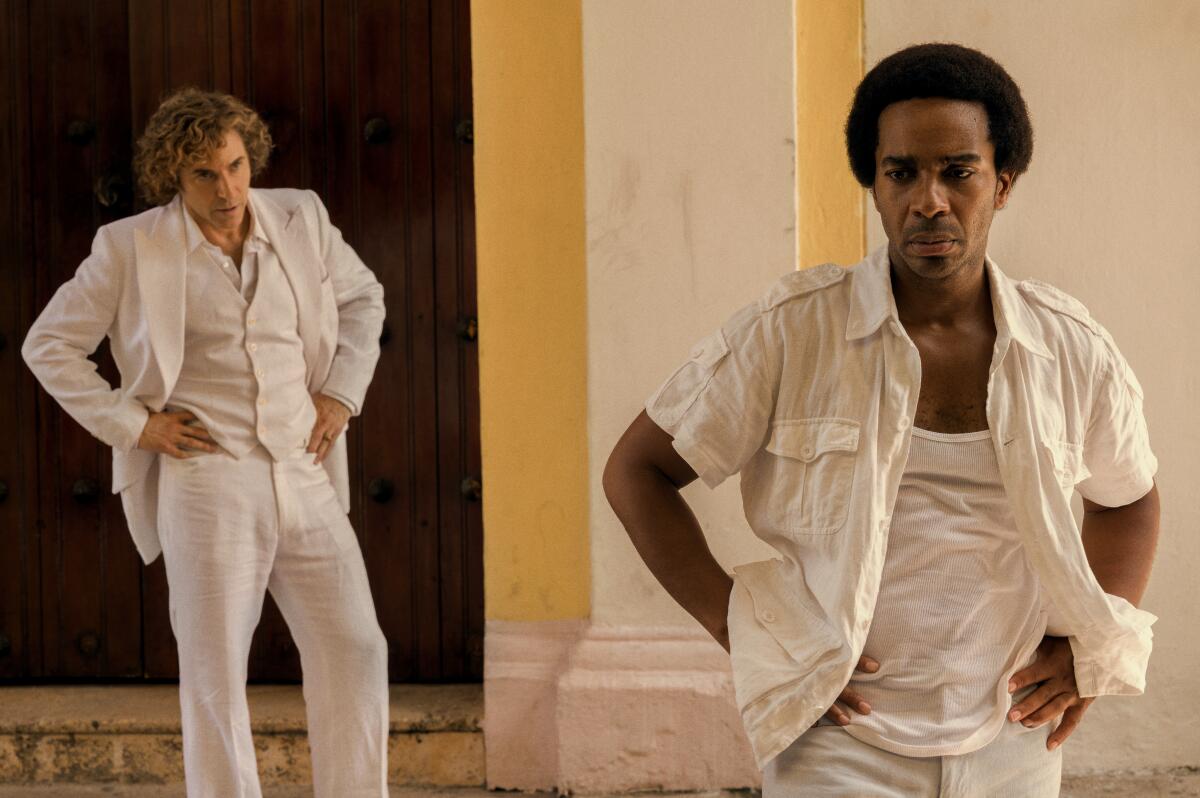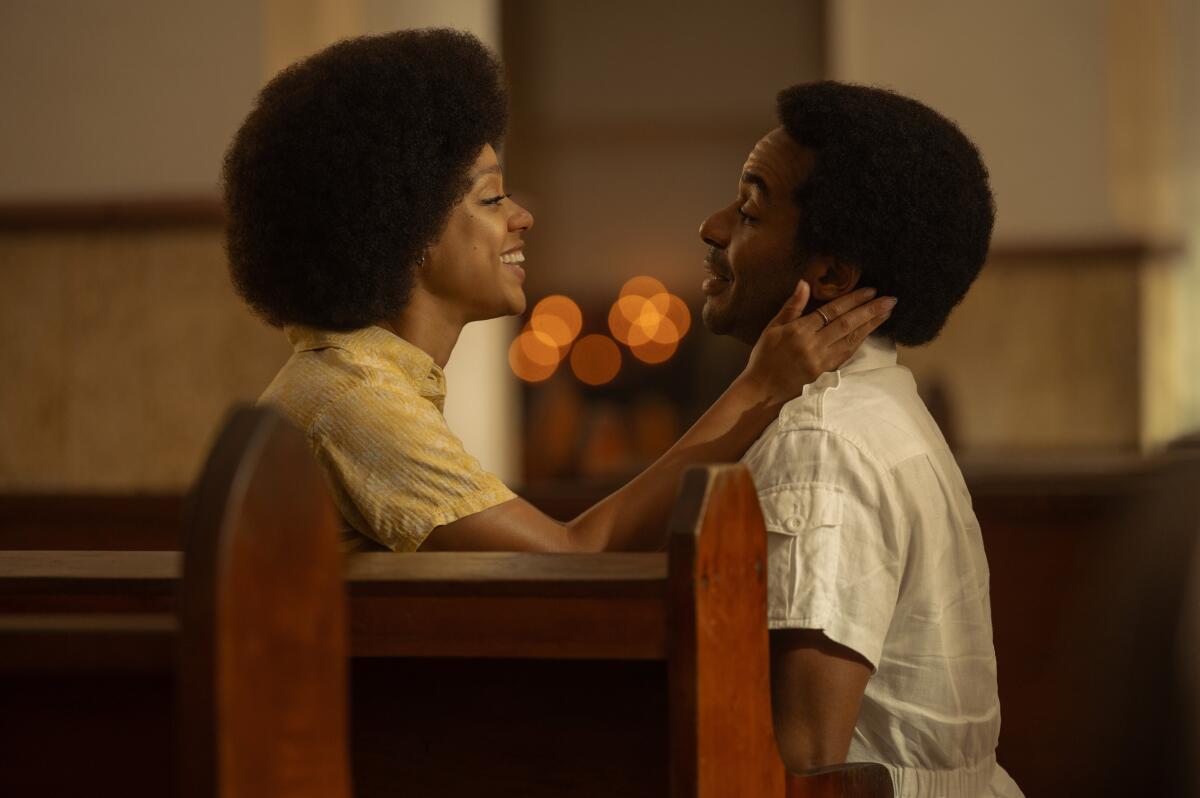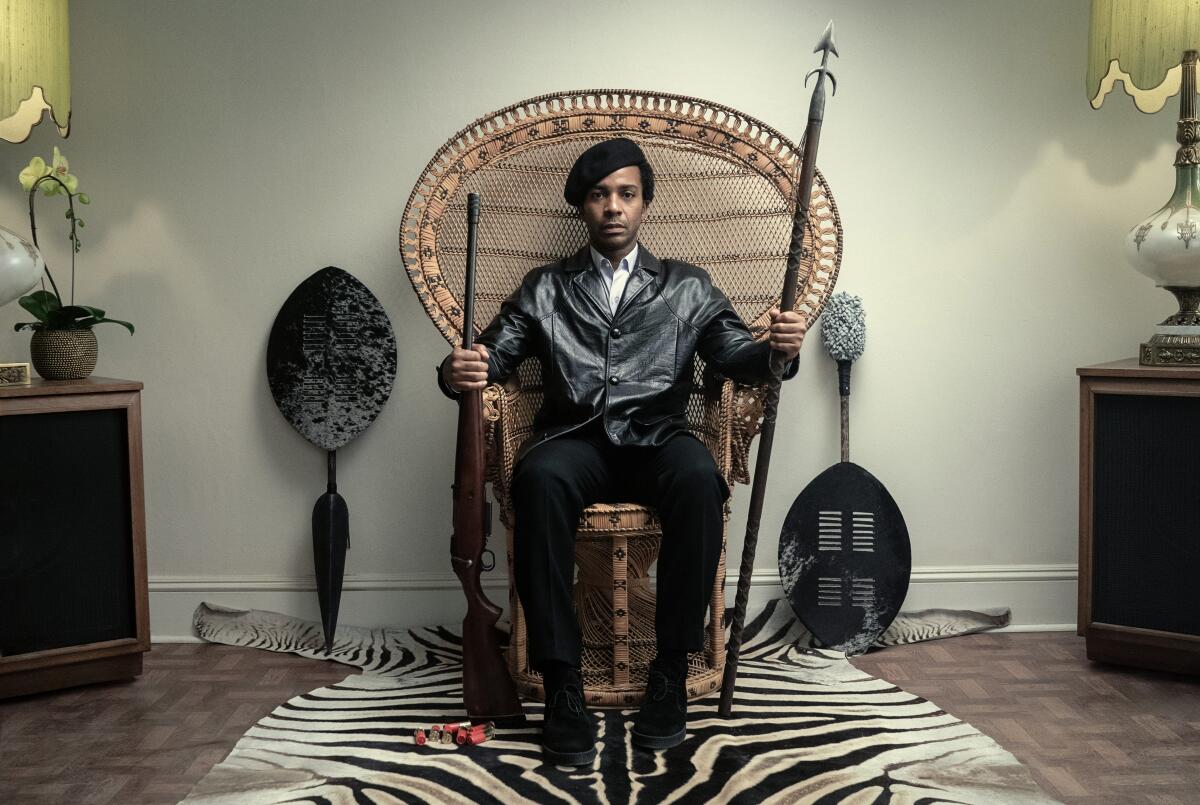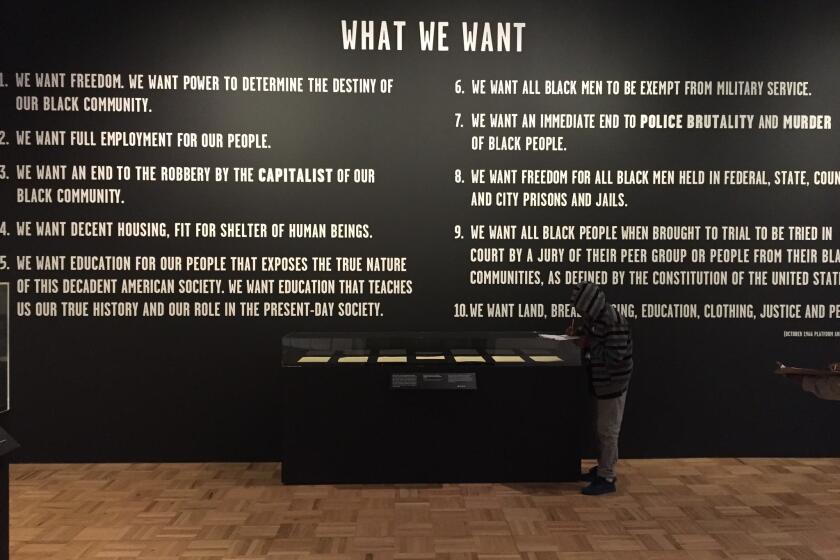‘The Big Cigar’ finale shows how Huey P. Newton realized Hollywood’s revolutionary potential

The very essence of “The Big Cigar” is frenetic. The Apple TV+ limited series, a slice-of-life biopic, follows the stranger-than-fiction story of Huey P. Newton — the co-founder of the Black Panther Party, played by a stoic André Holland — and his escape from the FBI to exile in Cuba. The whole thing, from Oakland to Puerto Vallarta, Mexico, to Cozumel, is a scrambled, mad dash.
But Newton retains control of his narrative, neatly bookending it with narration. In 1974, Newton and his then-girlfriend, Gwen Fontaine (Tiffany Boone), turn up at the Beverly Hills doorstep of Hollywood producer Bert Schneider (Alessandro Nivola). Newton opens the show with a caveat: “The story I’m about to tell you is true. … But it is coming through the lens of Hollywood, so let’s see how much of my story they are really willing to show.”
And in the show’s finale, at a typewriter in a tranquil house in Cuba, he closes that loop with cautious optimism. “Hollywood’s where people go when they wanna escape,” he muses. “That’s where I ran to. And that’s the revolutionary potential of Hollywood. It can mold minds. It can create worlds that don’t exist and alter those that do.”
This is, after all, “a story about a storyteller who understood the power of storytelling to tell his own story,” said Joshuah Bearman, an executive producer on “The Big Cigar” whose 2012 Playboy article is the basis of the series.

“The Big Cigar” unfolds four years after Newton was released from prison, having served three years in facilities around California, including solitary confinement at the Alameda County jail, known as the ‘‘soul breaker,” and the “hole” at San Luis Obispo, which Newton described as a “torture chamber.” His mind has grown increasingly fractured — due to the soul breaker, the constant surveillance of the FBI’s Counter Intelligence Program (COINTELPRO) and a burgeoning drug addiction — and the show paints a stark portrait of his dizzying descent into paranoia.
Malcolm X was assassinated in 1965, the Rev. Martin Luther King Jr. in 1968 and Fred Hampton in 1969. This was “a world in which you know, and you’re being warned, that you are not going to make it,” said showrunner and executive producer Janine Sherman Barrois, who also co-wrote two episodes.
The Apple TV+ series looks at the relationship between Black Panther Huey P. Newton and Hollywood producer Bert Schneider as they plan a fake movie to usher Newton’s escape.
At this particular moment, Newton was on edge, his senses were heightened and he was hyper aware of what it meant to work with Hollywood.
Bearman’s article details how Schneider, along with producing partner Stephen Blauner (P.J. Byrne), made up a movie, also titled “The Big Cigar,” as a cover to get Newton (code name “the star”) to Cuba. The movie was fake, but the Hollywood connections were very real: Schneider produced the landmark film “Easy Rider,” helped to engineer the band the Monkees, and his father was president of Columbia Pictures.
“I think the truth is that Huey was not that conflicted about Hollywood,” Bearman said. “He saw that power, the revolutionary power of media, and cinema in particular.”
After Bearman’s 2007 Wired article was adapted into the 2012 film “Argo,” Jim Hecht suggested that he write something similar about the story of Newton and Schneider. Newton died in 1989, so Bearman interviewed those who knew him instead: Fontaine, former Black Panther Party chairwoman Elaine Brown, his childhood friend David Hilliard (later chief of staff for the Black Panther Party) and other party members.
“If Huey was alive and working on the show, he probably also would have been exercising the type of critical analysis that the voice in the show is doing,” Bearman said. “It wasn’t that he just was like, ‘Oh, the movies. I get it, they’re great. They help us tell our story.’ It would have been a conversation and engagement.”

Newton knew and loved the 1966 film “The Battle of Algiers,” about rebels fighting in the Algerian War against the French government in North Africa, which is referenced in the show. He had been discussing making a movie about his own life with filmmaker Melvin Van Peebles. He was well aware of the power of the silver screen and understood the intrinsic relationship between media and politics.
The Black Panther Party — with its children’s breakfast program, child development center and People’s Cooperative Housing Program — needed to know how to wield that relationship. “If you’re trying to make change for your community, and you’re trying to make change in the world, you have to get it out somehow,” Barrois said. “They got on the news. They got the cameras to the social programs, they showed the police brutality.”
The corner of Market and 55th streets in Oakland is unremarkable in many ways.
Thus Newton, as Bearman said, had a keen understanding of image and perception. A scene in the show depicts his discomfort with the famous black-and-white image of him seated in a wicker chair, a bolt-action shotgun in one hand and a spear in the other. This was Panther leader Eldridge Cleaver’s idea, not Newton’s. The latter worried about it becoming iconographic, a symbol that could eclipse or distort the movement.
“He sees the revolutionary potential of culture and art,” Hecht said. “And he sees that’s a key pillar in the revolution, yes. But … it’s a weapon. It’s not inherently good or bad. Movies and television aren’t a pure presence that you can point to and go, ‘There it is!’, … so much as it’s a thing that, in the hands of humans — like AI [artificial intelligence] or anything else — can be shaped and can be used for evil or it can be used for good.”

Hecht, an executive producer, is credited with developing the show and writing the pilot and the finale. It’s a deeply personal story for him, one that began in college, where he became deeply interested in civil disobedience, social movements and participatory democracy. And when he first heard the story, he was also in active addiction, like both Newton and Schneider were in the mid-1970s.
“There’s this saying, the personal is political,” Hecht said. “The thing I wanted to get to with this show is, if you want to revolutionize the world — or even just your life — … you have to be willing to revolutionize yourself.”
That sentiment gleams through too at the tail end of the finale. “Black kids and future comrades all around the world will create their own definition of revolution,” Newton narrates. Just before the credits roll, a montage of photos and videos from the 2020 Black Lives Matter protests flash by onscreen.
Black artists like herself, Barrois said, will continue to be rigorous with Hollywood, demanding that the industry shows the whole story — and sooner than 50 years later next time.
As for that ending, “he’s leaving them, passing the torch on to them, saying, ‘You tell your story, you tell all the history that needs to be told,” she said. “You hold up a mirror to society right now. Because if you don’t revolutionize yourself, we won’t have any form of revolution.”
More to Read
The complete guide to home viewing
Get Screen Gab for everything about the TV shows and streaming movies everyone’s talking about.
You may occasionally receive promotional content from the Los Angeles Times.









